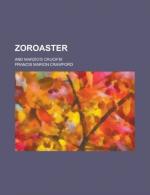“I did not expect to finish that nose,” said Marzio, rising from his stool. He was a punctual man, who exacted punctuality in others, and in spite of his thin frame and nervous ways, he loved his dinner. In five minutes all the men had left the workshop, and Marzio and his apprentice stood in the street, the former locking the heavy door with a lettered padlock, while the younger man sniffed the fresh spring air that blew from the west out of the square of San Carlo a Catenari down the Via dei Falegnami in which the establishment of the silver-chiseller was situated.
As Marzio fumbled with the fastenings of the door, two women came up and stopped. Marzio had his back turned, and Gianbattista touched his hat in silence. The younger of the two was a stout, black-haired woman of eight-and-thirty years, dressed in a costume of dark green cloth, which fitted very closely to her exuberantly-developed bust, and was somewhat too elaborately trimmed with imitation of jet and black ribands. A high bonnet, decorated with a bunch of purple glass grapes and dark green leaves, surmounted the lady’s massive head, and though carefully put on and neatly tied, seemed too small for the wearer. Her ears were adorned by long gold earrings, in each of which were three large garnets, and these trinkets dangled outside and over the riband of the bonnet, which passed under her chin. In her large hands, covered with tight black gloves, she carried a dark red parasol and a somewhat shabby little black leather bag with steel fastenings. The stout lady’s face was of the type common among the Roman women of the lower class—very broad and heavy, of a creamy white complexion, the upper lip shaded by a dark fringe of down, and the deep sleepy eyes surmounted by heavy straight eyebrows. Her hair, brought forward from under her bonnet, made smooth waves upon her low forehead and reappeared in thick coils at the back of her neck. Her nose was relatively small, but too thick and broad at the nostrils, although it departed but little from the straight line of the classic model. Altogether the Signora Pandolfi, christened Maria Luisa, and wife to Marzio the silver-chiseller, was a portly and pompous-looking person, who wore an air of knowing her position, and of being sure to maintain it. Nevertheless, there was a kindly expression in her fat face, and if her eyes looked sleepy they did not look dishonest.
Signora Pandolfi’s companion was her old maid-of-all-work, Assunta, commonly called Suntarella, without whom she rarely stirred abroad—a little old woman, in neat but dingy-coloured garments, with a grey woollen shawl drawn over her head like a cowl, instead of a bonnet.
Marzio finished fastening the door, and then turned round. On seeing his wife he remained silent for a moment, looking at her with an expression of dissatisfied inquiry. He had not expected her.
“Well?” he ejaculated at last.
“It is dinner time,” remarked the stout lady.




